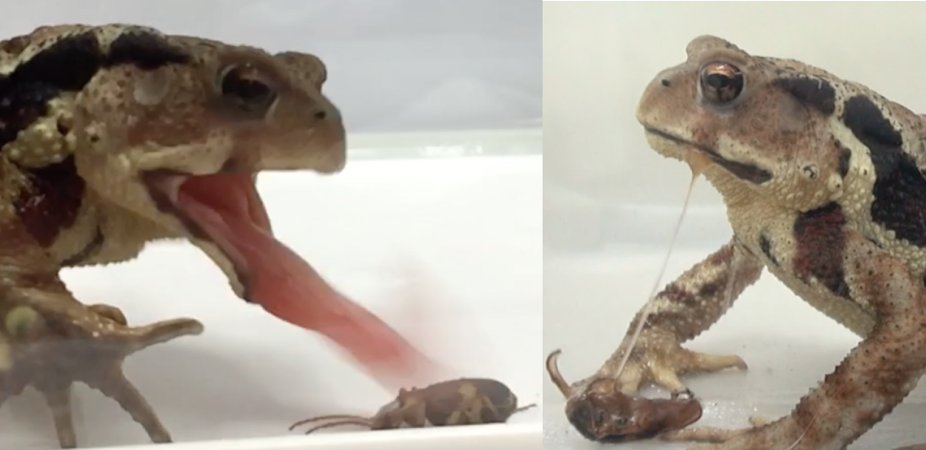In Disney’s film version of Pinnochio, the boy-puppet rescues his creator Geppetto by lighting a fire inside Monstro the whale, who has swallowed them both. The fire causes the whale to sneeze, freeing Pinnochio and Geppetto from their gastric prison.
Before you dismiss this getaway as incredible fantasy, consider that new research shows that a kind of fire in the belly can actually be an effective strategy for escaping predators in the real world. In fact, the animal kingdom is full of amazing examples of unusual defence mechanisms that help small creatures avoid a nasty fate.
In a new paper in Biology Letters, scientists at Kobe University in Japan describe how bombardier beetles can survive being eaten by a toad by releasing a hot chemical spray that makes the hungry amphibian vomit.
Bombardier beetles are so-named because, when threatened, they emit a boiling, irritating substance from their backsides with remarkable accuracy, to deter potential predators. They produce the caustic mixture by combining hydrogen peroxide, hydroquinones and chemical catalysts in a specially reinforced chamber at the base of their abdomen, which shields the beetle’s own organs from the resulting explosive reaction.
The Japanese researchers fed two different species of bombardier beetles to captive toads. They were then able to confirm that the beetles used their weapon inside the toads by listening carefully for the explosive pop that accompanies each discharge.
Toads are ambush predators, quite used to swallowing first and asking questions later. When they start to feel a dose of diner’s remorse, they can literally turn their stomachs inside out and scrape out the contents, rather than suffering meekly from indigestion. Many of the toads in this experiment did just that, disgorging the beetles up to 107 minutes after ingestion. Remarkably, the ejected beetles all survived.
In a further experiment, the researchers poked beetles with forceps to deplete their spray reserves. Compared to those with full tanks of fuel, the exhausted beetles were much less likely to be ejected. This showed that it really was their chemical arsenals that saved them, rather than just their taste or behaviour in the gut.

The bombardier beetle is of course not the only animal escape artist. The diverse getaway tactics of animals are a testament to the fascinating creativity of evolution. Subject to millions of years of abuse and exploitation by predators, natural selection has shaped an array of ingenious strategies for cheating death in the face of would-be devourers.
Animal Houdinis
Some examples are probably familiar to most people. For instance, many lizards drop their tails to distract a predator or escape from its venom. But others are more exotic. Sea cucumbers don’t have tails so they eject and regenerate their internal organs instead. Loud sounds (such as the “gunshots” of snapping shrimp) and bright colours (as on banded wing grasshoppers) are also effective means of startling predators. Mantid insects unite movement, sound and colour in an elaborate display that can stop an attack or at least give them a chance to escape.
Some animals fight back, such as the frogs that can erect sharp bony splinters from their claws that pierce their own skin, like X-Men’s Wolverine. Other animals, including the mimic octopus, prefer to pretend to be being dangerous, adopting the appearance of more deadly prey when threatened.
The stunning variety of defensive mechanisms would be impressive even if we only counted variations of chemical warfare, similar to the bombardier beetle’s steam treatment. There are the defensive toxins in pufferfish and poison arrow frogs, the nauseating odours of skunks, the charmingly named but actually revolting repugnatorial glands of some millipedes, and the projectile vomiting and faecal egg decorating of some birds.

Why should nature have created such an impressive array of defensive tactics? One possible explanation can be summarised as the life-dinner principle, articulated by biologists Richard Dawkins and John Krebs in the late 1970s. The argument is that predator and prey often face asymmetrical selection pressures, meaning that the stakes are different for the two competitors. If a predator fails to capture its target, it loses dinner, but if the prey fails to escape, it loses its life. Because the stakes are greater for prey, we shouldn’t be surprised they have developed so many impressive defences.
Understanding nature’s tremendous capacity to adapt should make us be careful. Humans interact with other organisms all the time, and usually we’re the predators. When we try to take action against other creatures to stop them spreading disease or eating crops, we should be mindful that evolutionary innovation can produce remarkable adaptations. For example, our widespread use of antibiotics and pesticides has spurred the evolution of organisms that are resistant to these methods.
Only by having a healthy respect for the relentless power of evolution can we hope to generate sustainable solutions to these kinds of problems. If we grow complacent and inattentive, we may some day soon find ourselves facing newly evasive diseases and pests, sputtering to breathe and dyspeptic amid all the fire and smoke in our bellies.

